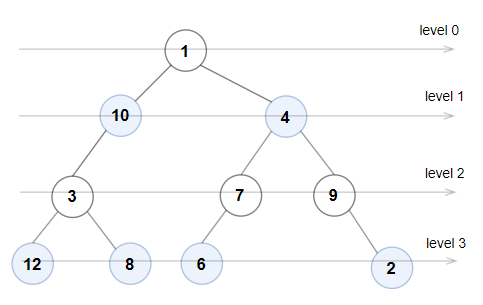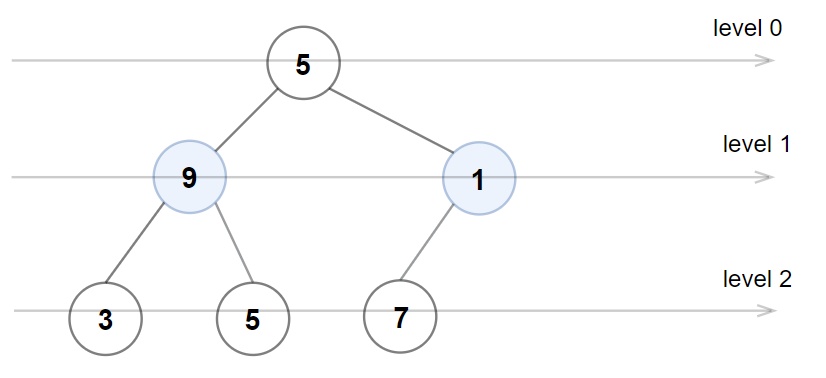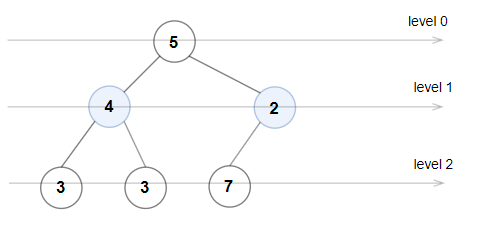英文原文
A binary tree is named Even-Odd if it meets the following conditions:
- The root of the binary tree is at level index
0, its children are at level index1, their children are at level index2, etc. - For every even-indexed level, all nodes at the level have odd integer values in strictly increasing order (from left to right).
- For every odd-indexed level, all nodes at the level have even integer values in strictly decreasing order (from left to right).
Given the root of a binary tree, return true if the binary tree is Even-Odd, otherwise return false.
Example 1:

Input: root = [1,10,4,3,null,7,9,12,8,6,null,null,2] Output: true Explanation: The node values on each level are: Level 0: [1] Level 1: [10,4] Level 2: [3,7,9] Level 3: [12,8,6,2] Since levels 0 and 2 are all odd and increasing, and levels 1 and 3 are all even and decreasing, the tree is Even-Odd.
Example 2:

Input: root = [5,4,2,3,3,7] Output: false Explanation: The node values on each level are: Level 0: [5] Level 1: [4,2] Level 2: [3,3,7] Node values in the level 2 must be in strictly increasing order, so the tree is not Even-Odd.
Example 3:

Input: root = [5,9,1,3,5,7] Output: false Explanation: Node values in the level 1 should be even integers.
Example 4:
Input: root = [1] Output: true
Example 5:
Input: root = [11,8,6,1,3,9,11,30,20,18,16,12,10,4,2,17] Output: true
Constraints:
- The number of nodes in the tree is in the range
[1, 105]. 1 <= Node.val <= 106
中文题目
如果一棵二叉树满足下述几个条件,则可以称为 奇偶树 :
- 二叉树根节点所在层下标为
0,根的子节点所在层下标为1,根的孙节点所在层下标为2,依此类推。 - 偶数下标 层上的所有节点的值都是 奇 整数,从左到右按顺序 严格递增
- 奇数下标 层上的所有节点的值都是 偶 整数,从左到右按顺序 严格递减
给你二叉树的根节点,如果二叉树为 奇偶树 ,则返回 true ,否则返回 false 。
示例 1:

输入:root = [1,10,4,3,null,7,9,12,8,6,null,null,2] 输出:true 解释:每一层的节点值分别是: 0 层:[1] 1 层:[10,4] 2 层:[3,7,9] 3 层:[12,8,6,2] 由于 0 层和 2 层上的节点值都是奇数且严格递增,而 1 层和 3 层上的节点值都是偶数且严格递减,因此这是一棵奇偶树。
示例 2:

输入:root = [5,4,2,3,3,7] 输出:false 解释:每一层的节点值分别是: 0 层:[5] 1 层:[4,2] 2 层:[3,3,7] 2 层上的节点值不满足严格递增的条件,所以这不是一棵奇偶树。
示例 3:

输入:root = [5,9,1,3,5,7] 输出:false 解释:1 层上的节点值应为偶数。
示例 4:
输入:root = [1] 输出:true
示例 5:
输入:root = [11,8,6,1,3,9,11,30,20,18,16,12,10,4,2,17] 输出:true
提示:
- 树中节点数在范围
[1, 105]内 1 <= Node.val <= 106
通过代码
高赞题解
解题思路
此处撰写解题思路
代码
/**
* Definition for a binary tree node.
* public class TreeNode {
* int val;
* TreeNode left;
* TreeNode right;
* TreeNode() {}
* TreeNode(int val) { this.val = val; }
* TreeNode(int val, TreeNode left, TreeNode right) {
* this.val = val;
* this.left = left;
* this.right = right;
* }
* }
*/
class Solution {
public boolean isEvenOddTree(TreeNode root) {
Queue<TreeNode> queue=new LinkedList<>();
List<List<Integer>> lists=new ArrayList<>();
if(root != null){
queue.add(root);
}
while(!queue.isEmpty()){
List<Integer> list=new ArrayList<>();
for(int i=queue.size();i>0;i--){
TreeNode tmp =queue.poll();
list.add(tmp.val);
if(tmp.left != null){
queue.add(tmp.left);
}
if(tmp.right != null){
queue.add(tmp.right);
}
}
lists.add(list);
}
if(lists.get(0).get(0) %2 == 0){
return false;
}
for(int i=1;i<lists.size();i++){
for(int j=0;j<lists.get(i).size();j++){
if(i%2!=0){
if(lists.get(i).get(j) %2!=0 ){
return false;
}
if(j+1<lists.get(i).size() &&(lists.get(i).get(j) %2!=0 || lists.get(i).get(j) - lists.get(i).get(j+1) < 0 || lists.get(i).get(j) ==lists.get(i).get(j+1) )){
return false;
}
}else{
if( lists.get(i).get(j) %2==0 ){
return false;
}
if(j+1<lists.get(i).size() && (lists.get(i).get(j) %2==0 || lists.get(i).get(j) - lists.get(i).get(j+1) > 0 || lists.get(i).get(j) ==lists.get(i).get(j+1) ) ){
return false;
}
}
}
}
return true;
}
}统计信息
| 通过次数 | 提交次数 | AC比率 |
|---|---|---|
| 7580 | 14821 | 51.1% |
提交历史
| 提交时间 | 提交结果 | 执行时间 | 内存消耗 | 语言 |
|---|




